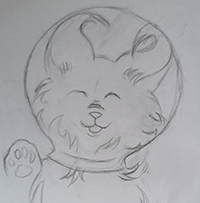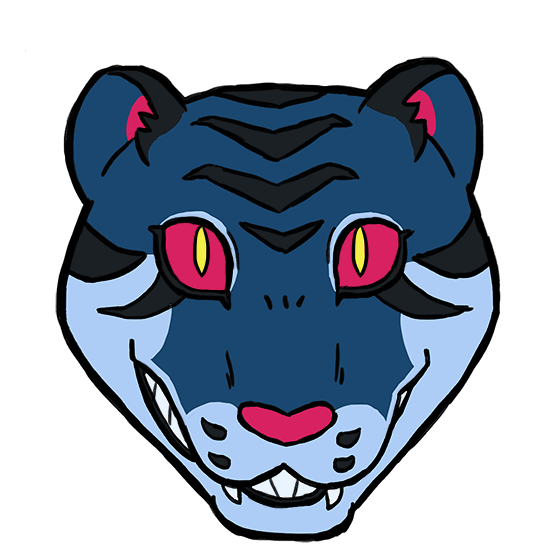Ninene (Nih-Ne-Ne)
Public sentientologic record
Property of the Royal Atheneum of Hövnís, Eörpe
Etymology & Definition
‘Ninene’ is a simplification of the lusoyans naming ‘Rseihneinu’ which translates to ‘Water Jewel’. It’s also an onomatopoeia of the light chirp-like noises many ninns make when they’re excited. As lusoyan naming is usually heavily descriptive and connotative, it could be based on the gem-like sheen of their coats (and the original breed of ninns were aquamarine in color) and their strange ability of being able to squeeze through very small spaces and fill containers. The latter still commonly raises the humor-laden, non-serious question ‘are ninns a liquid?’.History
The Ninns are one of several neolife species bioengineered by the lusoyans of Trirth through the use of DNA samples recovered the ARK Archives.The ARK Archives were biobanks found on several of the discovered Yggdrasil D-XX generation ships. The ancient humans likely collected genetic samples from their worlds to bring with them when they emigrated to the Rosepetal.
Origin
The DNA used as base for the bioengineering of the ninns was labeled as ‘Felis Catus’ in all of the ARK Archives found. While it can only be speculated what the ancestor-species exactly looked like, the morphology and anatomy of the first specimens of ninns created on Trirth gave a strong indication of how they may have looked and functioned. It’s highly likely they were only obligate carnivores and had coats following a more natural range of colors, textures, and patterns.Current Day
The ninns are the third most popular neolife pet in the United Worlds, preceded by the Mulilla and Vlooste. The totepillar is at a close fourth, while the Glissi is at fifth place.Habitat & Population
Geographic Origin
The ninns were originally created by lusoyan bioengineers on the planet Trirth.Galactic Distribution
In the Ascenancy the ninns were quickly made available to anyone with enough premium-currency to buy one through their government-sanctioned pet kennels. Breeding is tightly controlled and only allowed by these kennels, and all pets sold to private individuals have been sterilized beforehand. About 20 breeds are officially recognized in the Ascendancy and interbreeding with imported specimens is strictly forbidden. When they were introduced to the wider galaxy the initial exclusivity and high price tag led to only high- and middle-class (or analogue thereof) citizens would be able to afford a purebred cub. They became a status symbol often featured in the homes of the rich and successful. In the United Worlds and Rin Sovereignty the price tag eventually became low enough for it to be affordable to most people, partially a result of an increasing number of organizations being granted license to breed them. Roughly 30-35 new breeds have cropped up in the years since. Ninns are still prohibited in the Lukariat, alongside all other bioengineered pet species. In the Wheel, its illegal to breed and sell pets, but its allowed to own pets. For this reason, ninns have mostly remained exclusive to the upper classes as buying and importing pets is a rather involved and expensive process.Biology
Dietary Needs & Habits
Ninns are obligate carnivores and have specific requirements when it comes to dietary nutriments. Some of the nutriments they require are only found in meat such as taurine, arginine, and vitamin B6. They also have varying levels of difficulty digesting certain sugars, starches, and cellulose. For this reason, feeding ninns vegetarian foodstuff and milk-based products is not recommended. Since certain nutrients, including many vitamins and amino acids, degrade with temperature, pressure, and chemical treatments, they are commonly found as additives in manufactured ninene food in order to avoid nutritional deficiency.Fussy Eaters
The ninns have garnered a level of infamy for being very picky eaters and will commonly exhibit a dislike for chilled food, novel flavor neophobia, and conditioned taste aversion. Some ninns also develop a condition that causes an abnormal desire to eat or chew on non-food items such as certain textiles, plastics, papers, strings, thin metallic foils or even coal. Eating inappropriate items can threaten their health depending on the amount and toxicity of the items consumed.Genetics
The ninns are split into two subspecies based on their respiration requirements. F. Hilaris Solares requires a Type I Solyxide-base atmosphere in order to survive. They also need sufficient levels of bahtoanite mineral as is common to most species living on worlds featuring this atmosphere type. F. Hilaris Oxyles requires a Type I Oxygen-base atmosphere in order to survive.Life Cycle
A properly cared for ninene has an average lifespan of forty years.Reproduction
Ninns reproduce through internal fertilization via sexual intercourse, mimicking many of the mating behaviors of several known bionid feliforman lifeforms. In order to minimize the risk of exponential population increase through escaped, feral specimens, the females are limited to a predictable estrus cycle occurring every 320th day and then lasting for five to six days. Only during this time will the female will be in heat and receptable for mating.Hybridization
Ninns, as far as is known, is incapable of interbreeding with all bionid lifeforms as well as with other biotrona synthids. The two ninene subspecies are close enough in genetic makeup to make hybridization possible, which has led to unethical attempts made at cross-breeding. The differences in biological composition between the subspecies unfortunately means the majority of hybrid offspring will be born with congenital deformities and/or metabolic dysfunctions and die within days of being born.Growth Rate & Stages
After a gestation time of 40 days on average the female gives birth to one to three cubs that will remain reliant on their mother for nurturing and feeding until circa four months old. It’s ill advised to separate the cubs from their mother too early as this can lead to underdevelopment and behavioral disorders. Owners are encouraged to surgically sterilize any cubs not meant to be used for breeding programs before they reach puberty at 18-19 months old.Biological Variation
Since their creation ninns have been selectively bred into over fifty distinctive breeds with an even vaster amount of variation available if one covers the different coat lengths, textures, and patterns. The primary categorization of breeds is still based on the coloration of the eyes and the coat, often broadly grouped together in the colors green, red, blue, yellow, orange, green, pink, purple, brown, black, white, and exotic. In all but the exotic color grouping the coloration of the eyes and coat has to match, and they additionally need to have the ‘visual similitude’ of a recognized gemstone. This includes having an appropriate color hue and sheen. They additionally have to be solid-color, with black and white being the only allowed colors for patterns and shading. Exotic cover a fairly new set of breeds that incorporate two or three colors in the coat or has a pattern in a color other than black or white.Behavior
The leading adjectives used for describing a ninene in most advertisements is ‘independent’, ‘curious’, and ‘winsome’. The ninns are considered extremely social and loyal, but at the same time have a distinct level of personal integrity and independence not typically seen in other neolife pets. They are active, playful, and affectionate. Being both very intelligent and highly curious means they can require a lot of their owners in terms of engagement. Owners are typically recommended to play with and/or train their ninene at least twice a day for roughly twenty minutes. Since they become very attached and loyal to their family they can also easily be taught to travel with their owner on a leash or in a cage, and ‘adventuring’ is often a very effective means of entertaining a ninene. They’re known for developing different behavioral problems if their needs for mental stimulation and exercise aren’t met. This can trigger minor mischievous behaviors such as knocking over household items, poking or nipping their owners, or chasing their own tails. Or they can lead to the development of more serious problems such as making attempts to escape their enclosure/home, developing abnormal eating habits, or becoming depressed, anxious, or neurotic. Once a problematic behavior has developed it can be difficult to properly treat them without professional aid.
Taxological Data
Many Ninns
F. Hilaris Oxyles
50+ known breeds
Biological Data
Walking
The Rosepetal



I love that there is a document placeholder cause you were like "yeah, gonna have more here". I absolutely love the passion I feel in these articles. Like you're an excited biologist when someone asks "so, about them Ninene..." and you jump up like "OH, do I have something to tell you!" and you proceed to school everyone around with your unprecedented knowledge. It's just the best. I appreciate how thorough it all is.
Thank you, makes me so glad to hear. Given the right person to converse with I would absolutely talk their ears off about random scientific topics that caught my sight. I'm a knowledge omnivore who greatly enjoy learning just for the sake of it, and doing worldbuilding is my main means of applying what I've learnt. :) The placeholder was a means for me to avoid creating stub articles (I feel they quickly clutter the backend) while still communicating to my readers that related content is in the works.